Looking for Strap Locks for you guitar? Here’s what you need to know!
Strap locks are designed to replace your guitar’s strap button and prevent your strap from coming lose. The materials used on straps can wear and soften making them progressively more insecure over time. As you can imagine it is a very sad sight when a prized guitar hits the floor as a result of the strap coming lose!
Even so these are surprisingly not an original fitting for most guitars and if you want some, you need to install them yourself.
So let me help you with a rundown of the main ones on the market and some installation tips to make your job easier!
What strap locks are on the market?
There is a large number of different designs of strap lock on the market. Many work in a similar way with buttons screws and pins to lock the strap in place on your guitar. Others use various buckles and clips. Let’s run through the most trusted and popular ones to give you a general overview of what is available.
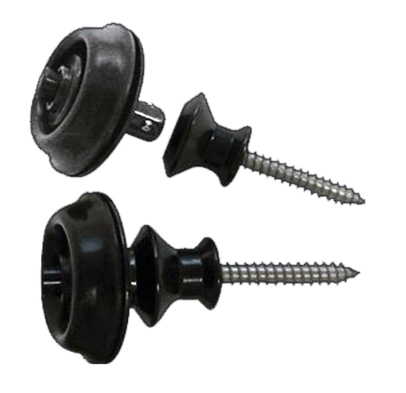
Used by many guitarist’s including Nita Strauss (guitarist for Alice Cooper) and Justin Derrico (guitarist for P!nk) and release tested up to 362kg (800lb) of pull. The Dunlop Straplok is among the most popular. You push the button at the end and the strap comes off the guitar.
Another stylish point these have going for them is they have two different types of button. The “Dual Design” and the “Flush Mount”. The Dual Design is like an ordinary button that you can use with or without the connector on the strap. The flush mount however can be totally inset into the guitar’s wood. This looks very stylish when installed but is not as versatile as it can only attaches to the rest of the Dunlop connector and needs a lot more drilling.
Some negative reviews bring up an issue of them rattling or being a bit lose. This is because they use a retaining clip rather than a nut. If this is the case, adding thin washers from the local DIY store will solve this.
The Schaller S-Lock is the next competitor. Sporting a slightly different design with a cup that the button rests in, it also uses a pin to hold it in place. The pin in this case is sprung and lifting it up allows the device to slide lose. They have now improved the design making them both easier to install and a locking screw makes sure it does not come lose when you do not want it to.
Though the design and style is a little different to the Dunlop model I see little difference in their usability. Both, if properly installed, stay firmly in place and both are easy to use and install.
However there are two points worth considering:
- These are slightly lower profile
- It is harder to pull a pin up by mistake to release the strap.
The lower profile means some guitar’s can fit in their cases without removing the strap. Also visually it is not meant to be the focus of the instrument so the less visible the better.
In terms of the pin I have not heard anyone complain about the dunlop one coming undone unintentionally. But logically bumping a button can release it. If the pin needs to be pulled up (as with the Schaller) this cannot happen by accident! Even if you do pull the pin out gravity will hold the guitar in the cup making it extra secure.
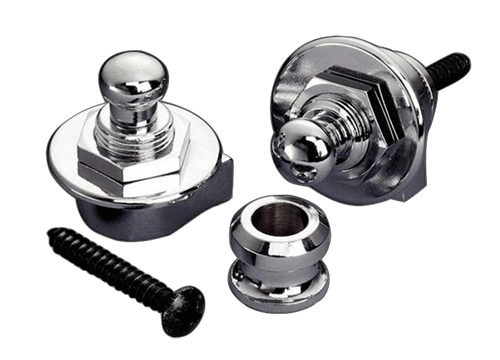
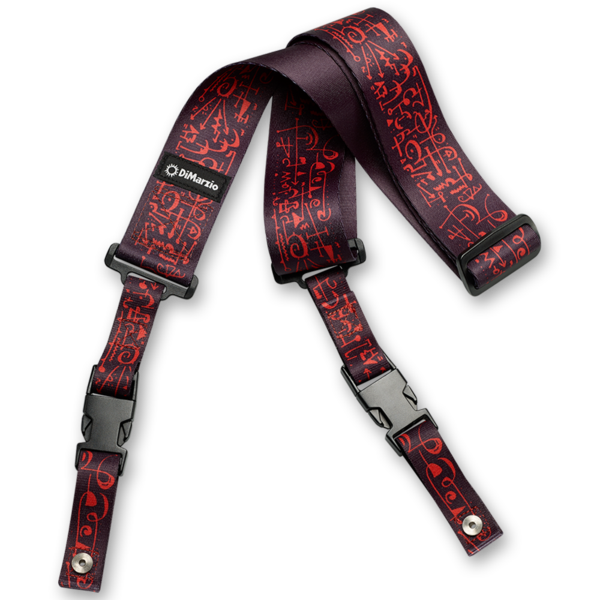
Made famous by Steve Vai and also used by John Petrucci the DiMarzio Cliplock takes a different approach to securing your strap. These screw into the guitar like the others but instead of screwing in a new button, you screw on part of the new strap. The rest of the strap is attached and released with a side release buckle.
There is not much to be said about the design as it is quite simple and robust. The obvious point with these however, is you cannot use your prized custom leather strap. As the strap is part of the unit you are stuck with their range. But DiMarzio make a number of different colours, high quality materials and widths to choose from. So if you have a list of guitars each with their own strap then this could be an option for you.
The Straptight is perhaps the simplest solution. It copies an idea used for years of cutting a guitar pick so it can clip over your strap when it is on the guitar. However, they refine this idea in terms of materials and quality.
However, I would consider this product as in a category of its own. It has in my mind very different uses and very different drawbacks making a direct comparison impossible.
For instance, I occasionally play on around thirty different guitars a week! As most of these are not mine I cannot go installing strap locks on all of them. The same idea applies for when I am teaching. Most new students do not have strap locks or have an old strap that keeps falling off (far more common than you would think). In this case having some on hand means you can get both your student and their guitar safely through the lesson. So having some of these in your guitar kit can be very useful! But personally I have them as a backup rather than for my workhorse guitars.
Unfortunately these are a little like plectrums and are very easily lost as they are not connected to the strap or guitar. This may be fine in the bedroom but unless you have a box full of them on tour then it is just another thing to need to worry about. Because of this you may end up needing to buy far more over a few years. This makes their price over time comparable to if not more than the initial investment of the other strap locks on the list.
As you can see very different uses to the other strap locks! So I would by no means rely on these as a replacement but I still always keep a pair in my guitar kit. They do come in handy and are a neat solution when needed.
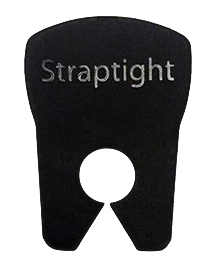
Tips for installing your strap locks
The instructions for many of the strap locks will simple say to unscrew and replace the button. But this is not always as simple so here are some tips for if you run into difficulties.
Ideally use the original screw
Though the new strap lock mostly come with their own screws it is advisable to try use your guitar’s original screws. Why is this I hear you ask? The logic here is very simple but worth noting. The hole in the guitar has already been drilled for the original screw and that screw’s thread has already cut into the wood. By reusing the original screw you can ensure a good secure fit. But using a new screw that is marginally too big can damage the wood. On the other hand by using a thinner screw you run the risk of it coming loose.
However, on some guitars the original screw is too big to fit through the strap lock’s button. So what do you do if this is the case? Essentially we have the issue of the hole being larger than the screw. Here we have two solutions:
- Edit the button
- Partially fill the hole if the new screw is thinner
- Drill out the hole if the new screw thicker
1. Edit the button
If at all possible I would personally take a small metal file or dremel attachment to the new button and try to widen the hole in order to use the original screw. I feel the advantages of this in regards to the guitar’s wood outweigh the effort. But sometimes this is not possible if the difference is significant. In this case I would move on to option two.
2. Partially fill the hole
Here we take some experience from luthiers I have talked to over the years. All you need is a match and some wood glue. The match (without its head) serves as a filler to narrow down the size of the screw hole. Initially the match will be too thick so split it down the middle and carve it until it takes up about a third of the hole diameter. This is usually enough but of course gauge it for the screws you are using. Now put a conservative amount of wood specific glue on the resized match and push it into the hole cutting it off level with the top. If done correctly and neatly the new screw will now fit and its thread will be able to bite into the match.
Be very careful doing this as there is a temptation to make the new screw very tight. Of course the whole point is having the strap as secure as possible. But this pressure from the screw can easily crack the guitar’s wood if it is too tight.
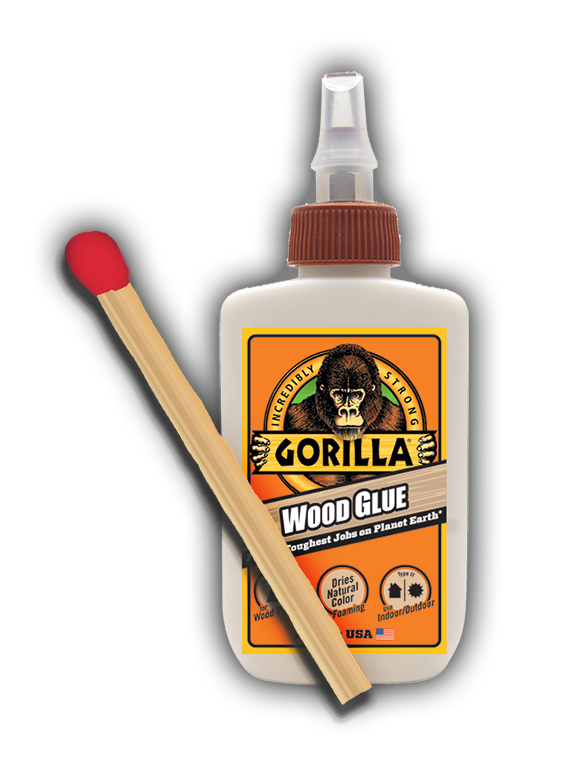

3. Drilling out the hole if the new screw is thicker
Something none of us want to do is take a drill to our guitars. But if the only screw you can use is thicker and there is no other solution but to use it do not force it in! This can crack the wood of your guitar far easier than you would think. Instead measure the width of the screw and find a drill bit of the correct size. This is not the exact width of the screw because you want the screws thread to bite into the wood. So get a separate piece of wood and test it out first so you are sure of how it fits.
Now drill very carefully and slowly into the original hole to widen it for the new screw. It is a good idea to put some tape or a mark around the drill bit to mark the depth you want.
Extra Tip!
Lubricating the screw thread with a dry bar of soap before installing it is far easier. Soap works well instead of grease or oil as it does not soften the wood around it. Candle wax can also work for this.

Conclusion
So far I have tried to offer as unbiased a review of these as possible so you can choose what is best for you. But I bet you are wondering by now which strap lock I opt for! Well the Schaller S-Locks have been my personal choice for many years. I find they have the edge on the other designs in term of simplicity and function while being one of the least imposing. This does not necessarily mean it is the right choice for you. But I can say that barring minutiae all of the above will do their job.
As you can see there is an overwhelming use of strap locks by professional guitarists on stage! There are also a number of different designs to choose from depending on your criteria. So for the price I would say any of the above make an essential investment for any guitars. This offers you a confidence on stage or at home that will not only let you worry less and focus on your music, but this will also show in your performance!
Did you find this page useful? If so be amazing and share it with your friends! And don’t forget to Follow me on Facebook, Stay up-to-date on my Twitter and See the latest pictures and videos on Instagram. I’ll see you in the next article!


It’s a weird coincidence that always after the fact these articles show up on my phone. I just ordered a set of strap locks a couple of days ago. It’s like “now they tell me !”
Welcome to the Straplock world Mark! You’re welcome to drop me a question about your new strap locks if you have any